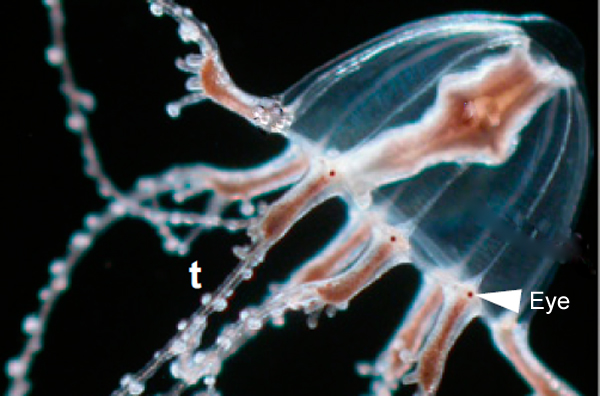The box jellyfish has surprisingly stereotypic set of 24 eyes with each rhopalium carrying 6 eyes of four different types. Although the jellyfish eyes do not form images the way our eyes do but they are highly sensitive to light and are equipped with cornea, lenses, and retinas. The nueropil (a network of nerve fibers) is likely to be involved in the diurnal activity. That is why most box jellyfish species are active during the day. Research is being carried out in order to understand the genetic basis of cubozoans’ visual information. Box jellyfish are possibly the only jellyfish with an active visual system.
Do Box Jellyfish have Eyes?
Radial Symmetry
While box jellyfish have no brains they do possess sharp eyesight. Thanks to its radial symmetry—which is probably an adaptation to see things in all directions and become equally effective in receiving stimuli from all directions. However, since box jellyfish lacks central nervous system they are unable to process images the eyes receive.
Rhopalia
Unlike the primitive jellyfish the cubozoans or box jellyfish are thought to possess rather complex visual mechanisms. Cubozoans eyes are fixed into the small sensory structure called rhopalia inside the bell. Each of these rhopalium eyes operates like a camera and resembles with that of squid or other vertebrates.
Simple Eyes, Ocelli
There are petal-like leaves that circle the rhopalium. Out of every six eyes on each of the rhopalium, four of them are simple. These simple eyes are known as ocelli. Box jellyfish distinguishes light and dark with the help of ocelli.
Complex Eyes
The remaining two eyes are virtually complex. Thus the total number of complex eyes is eight in a single box jellyfish. Each of the complex eyes is composed of lens, cornea and a retina. The cornea (along with epithelium) is directly linked to the lens and there is no iris between the two. The lens keeps the focus of a jellyfish.
Alongside camera-type eyes, pair of slit and pit eyes are also attached. They are called photoreceptors. Despite these photoreceptors jellyfish cannot distinguish colors but they do have the ability to prefer lighter objects over darker objects. This ability helps the animal to avoid underwater barriers including rocks and predators. The box jellyfish eyes are also acute to any nearby movement. Their power to detect motion gives them upper hand over many other true jellyfish (Scyphozoa).

The lens is attached to the uppermost and lowermost eyes of the box jellyfish. The animal has also pit eyes and slit eyes. One of the Caribbean jellyfish species, Tripedalia cystophora is known to demonstrate complex visual behavior in that it can easily avoid obstacles or swim fast in a specific direction. The Tripedalia cystophora possesses such a remarkable vision that it relies on sight to prey on zooplankton. The box jellyfish eyesight is sharp enough to differentiate between the mangrove roots and copepods in the presence of light. T. cystophora has a complete view of its surroundings.
The box jellyfish also possesses a tiny organ of balance known as statocyst. With the help of statocyst, jellies can easily maneuver while swimming through the ocean water. Inside the statocyst there is a calcareous particle which stimulates sensory receptors in response to gravity, thereby making sure the balance is maintained. This calcareous particle is called statolith. The statolith is primarily responsible for maintaining an absolute balance during movement.


Leave a Reply